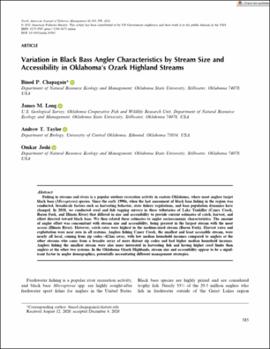| dc.contributor.author | Chapagain, Binod P. | |
| dc.contributor.author | Long, James M. | |
| dc.contributor.author | Taylor, Andrew T. | |
| dc.contributor.author | Joshi, Omkar | |
| dc.date.accessioned | 2022-02-15T17:20:48Z | |
| dc.date.available | 2022-02-15T17:20:48Z | |
| dc.date.issued | 2021-01 | |
| dc.identifier | oksd_ChapagainLongJoshi_variationinblackbassangler_2021 | |
| dc.identifier.citation | Chapagain, B. P., Long, J. M., Taylor, A. T., & Joshi, O. (2021). Variation in black bass angler characteristics by stream size and accessibility in Oklahoma's Ozark Highland streams. North American Journal of Fisheries Management, 41(3), pp. 585-599. https://doi.org/10.1002/nafm.10565 | |
| dc.identifier.uri | https://hdl.handle.net/11244/334600 | |
| dc.description.abstract | Fishing in streams and rivers is a popular outdoor recreation activity in eastern Oklahoma, where most anglers target black bass (Micropterus) species. Since the early 1990s, when the last assessment of black bass fishing in the region was conducted, broadscale factors such as harvesting behavior, state fishery regulations, and bass population dynamics have changed. In 2018, we conducted creel and fish tagging surveys in three tributaries of Lake Tenkiller (Caney Creek, Baron Fork, and Illinois River) that differed in size and accessibility to provide current estimates of catch, harvest, and effort directed toward black bass. We then related these estimates to angler socioeconomic characteristics. The amount of angler effort was concomitant with stream size and accessibility, being greatest in the largest stream with the most access (Illinois River). However, catch rates were highest in the medium-sized stream (Baron Fork). Harvest rates and exploitation were near zero in all systems. Anglers fishing Caney Creek, the smallest and least accessible stream, were nearly all local, coming from zip codes ~42 km away, with low median household incomes compared to anglers at the other streams who came from a broader array of more distant zip codes and had higher median household incomes. Anglers fishing the smallest stream were also more interested in harvesting fish and having higher creel limits than anglers at the other two systems. In the Oklahoma Ozark Highlands, stream size and accessibility appear to be a significant factor in angler demographics, potentially necessitating different management strategies. | |
| dc.format | application/pdf | |
| dc.language | en_US | |
| dc.publisher | Wiley | |
| dc.relation.ispartof | North American Journal of Fisheries Management, 41 (3) | |
| dc.rights | This material has been previously published. In the Oklahoma State University Library's institutional repository this version is made available through the open access principles and the terms of agreement/consent between the author(s) and the publisher. The permission policy on the use, reproduction or distribution of the material falls under fair use for educational, scholarship, and research purposes. Contact Digital Resources and Discovery Services at lib-dls@okstate.edu or 405-744-9161 for further information. | |
| dc.title | Variation in black bass angler characteristics by stream size and accessibility in Oklahoma's Ozark Highland streams | |
| dc.date.updated | 2022-02-09T14:24:40Z | |
| osu.filename | oksd_ChapagainLongJoshi_variationinblackbassangler_2021.pdf | |
| dc.description.peerreview | Peer reviewed | |
| dc.identifier.doi | 10.1002/nafm.10565 | |
| dc.description.department | Natural Resource Ecology and Management | |
| dc.type.genre | Article | |
| dc.type.material | Text | |
| dc.identifier.author | ScopusID: 56497802300 (Chapagain, BP) | |
| dc.identifier.author | ScopusID: 57210962651 (Long, JM) | |
| dc.identifier.author | ScopusID: 56042683700 (Taylor, AT) | |
| dc.identifier.author | ScopusID: 36782538200 (Joshi, O) | |
| dc.identifier.author | ORCID: 0000-0002-3900-6990 (Chapagain, BP) | |
| dc.identifier.author | ORCID: 0000-0002-8658-9949 (Long, JM) | |
| dc.identifier.author | ORCID: 0000-0002-8491-9967 (Taylor, AT) | |
| dc.identifier.author | ORCID: 0000-0002-3254-6628 (Joshi, O) | |
